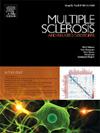The influence of manual dexterity on processing speed assessment in multiple sclerosis: A comparison of the PST and oral SDMT
IF 2.9
3区 医学
Q2 CLINICAL NEUROLOGY
引用次数: 0
Abstract
Cognitive impairment (CI) is a common symptom in persons with Multiple Sclerosis (PwMS), specifically information processing speed (IPS) impairment. The Symbol Digit Modalities Test (SDMT), which requires in-person testing, is a well-established measure for screening for IPS and CI in clinic settings. The Processing Speed Test (PST), a self-administered iPad-based tool, has been proposed as an alternative. Preliminary studies suggest that the PST can effectively differentiate PwMS from healthy controls and correlates with MRI results. This study aims to investigate if the relationship between the PST and oral SDMT is affected by manual dexterity or level of disability. A cohort of 100 PwMS completed both the PST and SDMT, as well the 9-Hole Peg Test (9HPT) and Expanded Disability Status Scale (EDSS). The strong positive correlation found between the PST and SDMT was maintained across all subgroups based on 9HPT performance and EDSS functional system scores. Our findings indicate that the PST is comparable to the SDMT for PwMS regardless of manual dexterity. This validates PST as a time-efficient, self-administered alternative that can reduce clinical burden in MS care.
手灵巧度对多发性硬化症处理速度评估的影响:PST和口腔SDMT的比较
认知障碍(CI)是多发性硬化症(PwMS)患者的常见症状,尤其是信息处理速度(IPS)障碍。符号数字模式测试(SDMT),需要亲自测试,是一个行之有效的措施,筛选IPS和CI在临床设置。处理速度测试(PST)是一种基于ipad的自我管理工具,已被提议作为一种替代方法。初步研究表明,PST可以有效区分PwMS与健康对照,并与MRI结果相关。本研究旨在探讨PST与口腔SDMT之间的关系是否受到手灵巧度或残疾程度的影响。一组100名PwMS完成了PST和SDMT,以及9孔Peg测试(9HPT)和扩展残疾状态量表(EDSS)。基于9HPT表现和EDSS功能系统评分,PST和SDMT之间的强正相关在所有亚组中保持。我们的研究结果表明,无论手工灵巧度如何,PST与SDMT相当。这证实了PST是一种省时、自我管理的替代方案,可以减轻MS护理的临床负担。
本文章由计算机程序翻译,如有差异,请以英文原文为准。
求助全文
约1分钟内获得全文
求助全文
来源期刊

Multiple sclerosis and related disorders
CLINICAL NEUROLOGY-
CiteScore
5.80
自引率
20.00%
发文量
814
审稿时长
66 days
期刊介绍:
Multiple Sclerosis is an area of ever expanding research and escalating publications. Multiple Sclerosis and Related Disorders is a wide ranging international journal supported by key researchers from all neuroscience domains that focus on MS and associated disease of the central nervous system. The primary aim of this new journal is the rapid publication of high quality original research in the field. Important secondary aims will be timely updates and editorials on important scientific and clinical care advances, controversies in the field, and invited opinion articles from current thought leaders on topical issues. One section of the journal will focus on teaching, written to enhance the practice of community and academic neurologists involved in the care of MS patients. Summaries of key articles written for a lay audience will be provided as an on-line resource.
A team of four chief editors is supported by leading section editors who will commission and appraise original and review articles concerning: clinical neurology, neuroimaging, neuropathology, neuroepidemiology, therapeutics, genetics / transcriptomics, experimental models, neuroimmunology, biomarkers, neuropsychology, neurorehabilitation, measurement scales, teaching, neuroethics and lay communication.
 求助内容:
求助内容: 应助结果提醒方式:
应助结果提醒方式:


